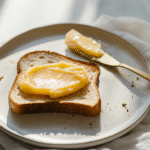Homemade Lemon Curd
Lemon curd is one of those timeless classics that brings a burst of sunshine to any dish. This luscious, silky spread combines the bright, zesty flavor of fresh lemons with a rich, buttery smoothness that feels indulgent yet fresh. Making lemon curd at home is surprisingly simple, and once you try it, you’ll never want to go back to store-bought versions. The secret to achieving that perfect texture is cooking it gently over simmering water in a double boiler, which prevents the eggs from scrambling and helps the curd thicken beautifully.
Using a glass or ceramic bowl for the double boiler is ideal because these materials are completely nonreactive. This means they won’t impart any metallic taste to the curd, which can sometimes happen if you use low-quality or scratched metal pans. However, if you prefer cooking directly on the stove, high-quality stainless steel pans labeled 18/10 or 18/8 generally work well and won’t affect the delicate lemon flavor. Brands like All-Clad and Cuisinart offer reliable options that professional chefs trust.
As the lemon curd cooks, you’ll notice it gradually thickening and becoming glossy, signaling it’s ready to be taken off the heat. Stirring in butter at the end adds a velvety richness that makes every spoonful melt in your mouth. The finished curd is perfect on toast, swirled into yogurt, or as a decadent filling for cakes and tarts.
Once cooled, store your lemon curd in the refrigerator where it will continue to thicken and develop even more depth of flavor. It keeps beautifully for up to a week, making it a versatile staple to have on hand for breakfast, dessert, or anytime you need a little bright, sweet tang in your life.
Making lemon curd from scratch may seem like a small culinary project, but it’s one that rewards you with pure homemade goodness and endless creative possibilities in the kitchen
- Prep Time: 10
- Cook Time: 8-10 minutes
- Total Time: 20 minutes including cooling
- Yield: approx. 1 cup
- Category: Sauces
- Method: Stovetop
- Cuisine: American
Ingredients
Instructions
-
Prepare Double Boiler:
Fill a saucepan with 1–2 inches of water. Bring to a gentle simmer over medium heat. Place a heatproof glass or ceramic bowl snugly on top without touching the water. -
Combine Ingredients:
In the bowl, whisk together sugar, eggs, lemon juice, and lemon zest. -
Cook the Curd:
Stir continuously with a whisk or spatula until the mixture thickens and coats the back of a spoon, about 8–10 minutes. Be patient and keep the heat gentle to avoid curdling. -
Finish with Butter:
Remove from heat and stir in butter pieces until melted and fully incorporated. The butter adds richness and silky texture. -
Cool and Store:
Pour the lemon curd into a clean jar or container. Cover and refrigerate. It will thicken further as it chills.
Notes
Tips
-
Cookware:
For best results and to avoid any metallic taste, use a glass or ceramic bowl as a double boiler to cook your lemon curd. These materials are nonreactive and safe for acidic lemon juice.
High-quality stainless steel pans labeled 18/10 or 18/8 are usually nonreactive, but if your pan is scratched or low quality, it may react slightly with the lemon and affect flavor. Trusted brands include All-Clad, Cuisinart Multiclad Pro, Calphalon Classic Stainless Steel, Demeyere, and Mauviel M’Cook. -
How to use glass or ceramic bowl:
Place the bowl on top of a saucepan with simmering water, ensuring it does not touch the water. Stir the curd constantly to prevent lumps and burning. -
Storage:
Lemon curd will keep refrigerated for up to 1 week. For longer storage, freeze in an airtight container for up to 3 months. -
Serving ideas:
Use lemon curd as a spread for toast or scones, a filling for cakes and tarts, or swirl it into yogurt or ice cream.
If you want me to format this as a blog post or add images prompts or call to action in Joyista style, just let me know! 💙
Nutrition Disclaimer: The nutritional information provided is an estimate based on standard ingredients and serving sizes. Actual values may vary depending on specific products used and portion sizes. This information is provided for convenience and should not be considered medical or dietary advice
Nutrition
- Serving Size: 2 tablespoons
- Calories: 110
- Fat: 7
- Carbohydrates: 12
- Protein: 1
Find it online: https://joyistalife.com/recipe/homemade-lemon-curd/
